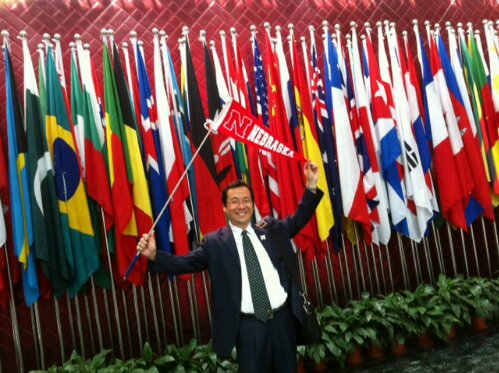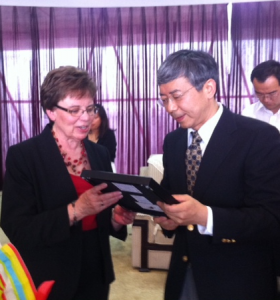 Today was a day that felt like school—it’s what we do. And we did it with lots of ceremony and lots of laughter. The morning began on the campus of Xi’an Jiaotong University, the sister university of UNL. It’s a lovely campus, with many trees, and a large square with statues symbolizing the four inventions of the early Chinese people: paper, print making, the compass, and gun powder. Graduation is approaching, and many students were in small groups around the campus, posing with friends for photos. We were there for the formal opening ceremony, hosted by the leaders of Xi’an Jiaotong University (XJTU), greeting us as the delegation from the UNL Confucius Institute. The President of the University, Nanning Zheng, hosted the morning ceremony. It was both formal, with formal seating and a definite protocol, and informal, because of the personable nature of President Zheng and David Lou, Director of the UNL Confucius Institute. Formality that honored the occasion, and ease that made all of us comfortable.
Today was a day that felt like school—it’s what we do. And we did it with lots of ceremony and lots of laughter. The morning began on the campus of Xi’an Jiaotong University, the sister university of UNL. It’s a lovely campus, with many trees, and a large square with statues symbolizing the four inventions of the early Chinese people: paper, print making, the compass, and gun powder. Graduation is approaching, and many students were in small groups around the campus, posing with friends for photos. We were there for the formal opening ceremony, hosted by the leaders of Xi’an Jiaotong University (XJTU), greeting us as the delegation from the UNL Confucius Institute. The President of the University, Nanning Zheng, hosted the morning ceremony. It was both formal, with formal seating and a definite protocol, and informal, because of the personable nature of President Zheng and David Lou, Director of the UNL Confucius Institute. Formality that honored the occasion, and ease that made all of us comfortable.
It is unusual for the President to meet with visiting delegations such as ours, so it was indeed an honor. Dr. Zheng had visited Nebraska earlier in this spring, giving the commencement address at UNL and receiving an honorary Doctor of Science degree. He is genuinely interested in the work of public school educators, and he liked the Nebraska people he had met earlier. The opening ceremony included remarks by Dr. Zheng and Dr. Lou; Alan Schneider, superintendent of ESU 5 in Nebraska, and I spoke on behalf of the Nebraska educators. It was an honor to do so. We also exchanged gifts; I was delighted to be able to present Dr. Zheng with a beautiful piece of Nancy Childs’ art. Nancy, as you know, works with and makes her own paper, so that was particularly appropriate for the President of a university in the country that created the process for making paper. We received lovely shadow puppets and fans, especially appreciated because of the very warm days in Xi’an in June. It was a gracious and centering way to begin the day.
President Zheng hosted a banquet in our honor at noon, and I was seated at his left hand. He talked about the similarities of the United States and China, both large countries with many people. I noted the importance of education for the future of both nations, and he agreed. Then, engineering professor that he is, he commented that he thought educators have “the human heart of the engineer.” It was a touching statement.
In the afternoon we had a Chinese language and culture class, and I remembered all over again how very difficult it is to begin to learn a new language. Our teacher was excellent, and we’re all learners sitting around the table. We’re motivated, we’re interested. And we struggled to learn to count to 10 in Chinese. It’s just hard. We also learned key elements of Chinese culture and history, including the timeline of the dynasties and the times during which paper, print making, the compass, and gun powder were invented. She taught us about the significance of the dragon in Chinese culture, and she taught us about Confucius and Confucianism. We were engaged throughout. We did much better with the culture and history part than the language, because we have some prior knowledge about culture and history. Most of us have absolutely no prior knowledge of the language, and without “hooks” in our brains to connect the new learning to old, it’s very difficult to learn brand new concepts or terms. Makes me all the more in awe of our English Language Learners and their teachers…..
Tomorrow, a visit to the City Wall and another lecture on the Chinese culture. Soon, for this blog, thoughts about food and photos….

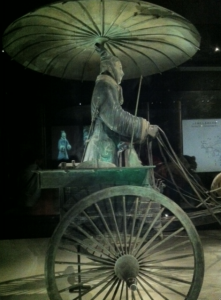 The story of the terra cotta warriors is one of the “grand sweep of history” stories. A young emperor, 2200 years ago, starts planning his mausoleum. The plans include being surrounded by terra cotta warriors–infantrymen, cavalry men, and soldiers in chariots. Over a period of 38 years, 700,000 men build the mausoleum and fill it with the terra cotta warriors. Thousands of life size warriors, horses, armor, and chariots. Thousands of the workers die in the process; it is hot, heavy, dangerous work. The emperor reigns for 38 years, conquering six other kingdoms and uniting China. He installs common weights and measures and common language characters, important actions for centuries to come. He dies, and he is interred in the mausoleum, surrounded by the terra cotta warriors. The warriors are in long corridors, with walls of hard packed earth separating the columns. The pits are protected by heavy wooden beams, covered with mats, and earth is filtered over all of it, masking its place for centuries to come.
The story of the terra cotta warriors is one of the “grand sweep of history” stories. A young emperor, 2200 years ago, starts planning his mausoleum. The plans include being surrounded by terra cotta warriors–infantrymen, cavalry men, and soldiers in chariots. Over a period of 38 years, 700,000 men build the mausoleum and fill it with the terra cotta warriors. Thousands of life size warriors, horses, armor, and chariots. Thousands of the workers die in the process; it is hot, heavy, dangerous work. The emperor reigns for 38 years, conquering six other kingdoms and uniting China. He installs common weights and measures and common language characters, important actions for centuries to come. He dies, and he is interred in the mausoleum, surrounded by the terra cotta warriors. The warriors are in long corridors, with walls of hard packed earth separating the columns. The pits are protected by heavy wooden beams, covered with mats, and earth is filtered over all of it, masking its place for centuries to come.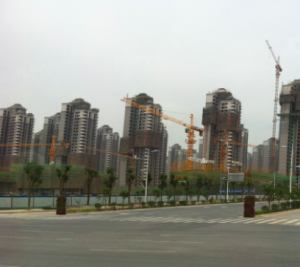 We arrived in Xi’an yesterday. As our new guide said, a small town of 8 million compared to the 16 million of Beijing. As we rode from the airport, she told us that the national bird is the crane. Then she laughed as she clarified that 70-80% of the world’s construction cranes are in China. From our ride and from our hotel window, I suspect that might be true for just Xi’an.
We arrived in Xi’an yesterday. As our new guide said, a small town of 8 million compared to the 16 million of Beijing. As we rode from the airport, she told us that the national bird is the crane. Then she laughed as she clarified that 70-80% of the world’s construction cranes are in China. From our ride and from our hotel window, I suspect that might be true for just Xi’an.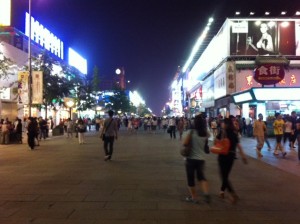 Modern: In the evening, we visited the equivalent of Times Square, Beijing style. Neon signs, Hermes, Tiffanys and other fancy, expensive stores I do not remember. Many people milled around with their bags of goods and cell phones texting. To get back to the hotel, We rode the subway around 9 pm. We were packed in so tightly, 7 of us literally pushed to get out of the subway car at our stop as the buzzer warned us the doors were closing. We, Nebraskans, looked frazzled by the lack of personal space and the need to push.
Modern: In the evening, we visited the equivalent of Times Square, Beijing style. Neon signs, Hermes, Tiffanys and other fancy, expensive stores I do not remember. Many people milled around with their bags of goods and cell phones texting. To get back to the hotel, We rode the subway around 9 pm. We were packed in so tightly, 7 of us literally pushed to get out of the subway car at our stop as the buzzer warned us the doors were closing. We, Nebraskans, looked frazzled by the lack of personal space and the need to push.
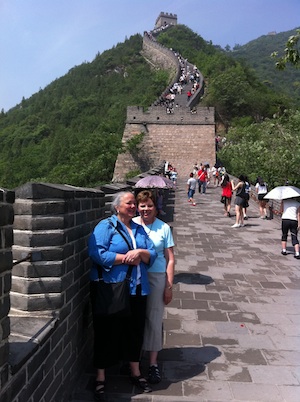
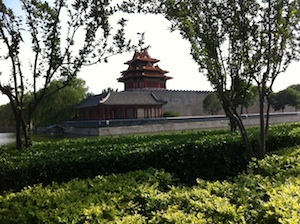 This afternoon we visited the Forbidden City, the home of the emperors of two dynasties spanning more than 500 years. It is a huge space, with an inner courtyard of 9,999 rooms, and it’s just grim. There are no trees, no plants, no earth. The earth has been covered over by at least three meters of rock and brick over the centuries, to prevent anyone from tunneling into the inner courtyard and attempting to assassinate the emperor. Elaborate systems of bridges, moats, and watch towers were constructed for the same reason. The emperor slept in a different room every night, to decrease the likelihood that someone in the inner family would assassinate him. The emperor (and I believe there were 24 that reigned during these two dynasties) may have been powerful, but the emperor’s energies were greatly occupied with avoiding assassination.
This afternoon we visited the Forbidden City, the home of the emperors of two dynasties spanning more than 500 years. It is a huge space, with an inner courtyard of 9,999 rooms, and it’s just grim. There are no trees, no plants, no earth. The earth has been covered over by at least three meters of rock and brick over the centuries, to prevent anyone from tunneling into the inner courtyard and attempting to assassinate the emperor. Elaborate systems of bridges, moats, and watch towers were constructed for the same reason. The emperor slept in a different room every night, to decrease the likelihood that someone in the inner family would assassinate him. The emperor (and I believe there were 24 that reigned during these two dynasties) may have been powerful, but the emperor’s energies were greatly occupied with avoiding assassination.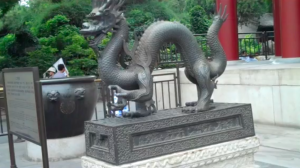 What we would call mythology plays a role in Chinese culture, past and present. We visited the Summer Palace today, which served as the summer home of the emperors for many years (hundreds? thousands? my sense of history is escaping me….) The many buildings, built around a large, shallow lake, have structures to prevent demons from entering them. The belief is that demons can only move in straight lines, so a large (and I mean really large) rock is placed several feet in front of the door to block the demon from entering. The belief is that demons can’t step up or down, so a raised threshold keeps the demons from entering. The belief is that demons can’t stand to look at themselves because they are ugly, so mirrors are placed in the entry hall to scare demons away if they do enter. According to our delightful guide Penn, it is not uncommon to have raised thresholds in households today….
What we would call mythology plays a role in Chinese culture, past and present. We visited the Summer Palace today, which served as the summer home of the emperors for many years (hundreds? thousands? my sense of history is escaping me….) The many buildings, built around a large, shallow lake, have structures to prevent demons from entering them. The belief is that demons can only move in straight lines, so a large (and I mean really large) rock is placed several feet in front of the door to block the demon from entering. The belief is that demons can’t step up or down, so a raised threshold keeps the demons from entering. The belief is that demons can’t stand to look at themselves because they are ugly, so mirrors are placed in the entry hall to scare demons away if they do enter. According to our delightful guide Penn, it is not uncommon to have raised thresholds in households today….